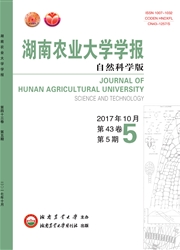

 中文摘要:
中文摘要:
通过Signa1P3.0、TargetP1.1、KohGPI、TMHMM2.0等系列软件对南方和北方根结线虫分泌蛋白组进行预测。结果表明,南方和北方根结线虫预测分泌蛋白数为2622和1696个,分别占总基因数的13.65%和12.95%。经BlastP(E〈le-10)分析,分别有754个和466个能在KOG(eukaryotic orthologous groups)库中找到相似蛋白,其功能主要包括能量代谢与转运、信号传导、转录活性调控等。基因本体(GO)分析结果表明,南方和北方根结线虫的预测分泌蛋白数目在核定位信号和转录活性调控上存在显著差异。用MEME/MAST搜索并分析根结线虫分泌信号肽保守的模体(Motif),得到54个南、北方根结线虫分泌信号肽共有的模体。
 英文摘要:
英文摘要:
Secretory proteins play an important role in the process of molecular interaction between pathogen and host plants. In this paper, we employed SignalP 3.0, TargetP 1.1, KohGPI and TMHMM 2.0 to predict the secretory proteins of root-knot nematode and finally we got 2 622 and 1 696 secretory proteins for Meloidogyne incognita and Meloidogyne hapla respectively, correspondingly accounted for 13.65% and 12.95% of the total proteins. 754 and 466 secretory proteins from Meloidogyne incognita and Meloidogyne hapla respectively showed homology to proteins in KOG (eukaryotic orthologous groups) database with blastp (E 〈le-10) The main functions of those homologous proteins in KOG database were related to energy metabolism, transport, signal transduction and regulation of transcriptional activity GO(gene ontology) analysis showed that M. incognita and M. hapla differed significantly in the number of secretory proteins for nuclear localization signal and transcription regulator activity. Finally, 54 motifs were found to be shared by the signal peptides ofM. incognita and M.. hapla using MEME / MAST.
 同期刊论文项目
同期刊论文项目
 同项目期刊论文
同项目期刊论文
 期刊信息
期刊信息
